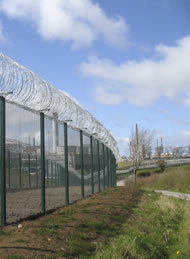There is nowhere like it on Earth. Hidden away on the shore of West Cumbria sits the most concentrated collection of radioactive wastes anywhere on the planet. Much of it has been all but abandoned for decades, for want of any way to make it safe or anywhere to dispose of it.
Eight years ago, Britain’s top scientists at The Royal Society called one of these stockpiles – the world’s largest store of plutonium – “a severe security risk”. Just yards away are two other waste silos that have been labelled Europe’s two most dangerous industrial sites. Another store holds hot and highly radioactive waste accumulating from reprocessing, which has the potential to cause widespread contamination across northern England. And that’s before we mention the sealed remains of a fire there almost 60 years ago, the world’s first major nuclear accident.
Sellafield – once known as Windscale – is Britain’s forgotten nuclear nightmare, at constant risk of terrorist attack, earthquake or power failure. Even the government agrees that, at best, cleaning the place up will cost almost £100 billion and take more than a century.
When climate negotiators sit down in Paris this December to try and conclude a deal on curbing greenhouse-gas emissions from burning fossil fuels, they will be lobbied by nuclear enthusiasts arguing that their technology could pioneer a low-carbon future, keeping the lights on without frying the planet. Even some environmentalists now believe that climate change should make us reassess the virtues of a nuclear-fuelled future.
But if the proponents of the nuclear option are serious, they must surely show that they can handle the lethal legacy of their operations to date. And the evidence from Sellafield suggests they are not yet up to the task. Far from clearing the legacy, they are still adding to it.
Windscale began as a nuclear bomb-making factory. Its reactors irradiated uranium fuel to manufacture plutonium, which was extracted from the fuel by dissolving it in nitric acid, a process called reprocessing.
The nuclear complex – sited, at government insistence, more than 50 miles from the nearest city – was built in a rush in the late 1940s. Bankrupt Britain had been refused access to post-war America’s nuclear bomb-making secrets, which its scientists had helped uncover. The plant operated in a rush too. Desperate efforts to keep up with US bomb-making prowess led to corner cutting in plutonium production, resulting in a fire at Windscale in 1957.
The fire unleashed a radioactive cloud that is estimated to have killed a hundred or more people. And it left behind at Windscale the first lethal legacy. The sealed remains of the burned reactor, including 15 tonnes of charred and buckled fuel, have been left untouched ever since, because of uncertainty about whether breaking the seal might reignite the fire. Decommissioning has been put off till the 2030s.
At around the time of the fire, Britain became the first country in the world to embark on a massive programme of constructing nuclear reactors to generate electricity. The nuclear power stations used the massive amounts of heat created in the reactors to drive turbines. The spent fuel from the reactors was sent to Sellafield, where plutonium continued to be extracted. Some of the plutonium was used for bombs, but increasingly it was set aside as fuel for a planned future generation of nuclear reactors.
In the 1970s and 1980s, Britain had big plans for making Sellafield a major revenue earner. The idea was to create a world centre for reprocessing. It would convert spent fuel from nuclear reactors in countries like Japan and Germany into new fuel. But the problems that followed from that decision have proliferated.
First, the reprocessing technology wasn’t very good. For decades, both deliberately and accidentally, Sellafield loosed radioactive materials up its chimneys and down its discharge pipe into the Irish Sea. As a result there is so much radioactive plutonium and americium in mud on local shorelines today that, if dug up, it often qualifies as low-level radioactive waste that has to be buried at the site’s waste dump at Drigg. The resulting scandals helped turn Britain against nuclear power.
But the biggest hazards lie within the fences of Sellafield itself, where much greater amounts of radioactive materials lie in store. The site’s current manager, the Nuclear Decommissioning Authority, has given top priority to the contents of four decaying buildings that house the lethal remains of past blunders and penny-pinching. They are Sellafield’s dark heart.
Two of these buildings are open-air pools, each over 150 metres long. They house spent fuel that was delivered to Sellafield but, through management failures, was not reprocessed before the fuel began to corrode, after which reprocessing was impossible. The ponds are full of this decaying fuel, most of which has been there for 40 years and more. It has created hundreds of tonnes of radioactive sludges that now line the bottom of the ponds.
The other two buildings are huge silos where radioactive fuel packaging, known as cladding, has been dumped since the 1950s. This discarded waste too has corroded, creating hydrogen and a constant risk of fire.
These buildings should have been demolished long ago, and now leak radioactive liquids into the soil. Each will cost billions of pounds to empty and make safe. And while some work has started on this decommissioning, new problems keep emerging and the schedules keep slipping. Earlier this year, the completion dates for decommissioning two of the buildings were extended by five years, to 2030.
Leaving spent fuel around in cooling tanks has been bad. But the decommissioning process itself has created, if anything, more problems. Herein lies the third great legacy problem at Sellafield: what to do with the products of reprocessing. These products are the plutonium intended for making new nuclear fuel, and the highly radioactive waste liquids left over from reprocessing.
Sellafield’s civilian reprocessing activities were based on the assumption that the world was going nuclear. But in the aftermath of accidents at Three Mile Island in the US, and Chernobyl in Ukraine, the world lost its appetite for nuclear power. And that included Britain. The market for reprocessing spent fuels to provide new fuel dried up. British Nuclear Fuels, the company created by the government to conduct reprocessing, went bankrupt. And Sellafield got stuck with the plutonium.
As a result, somewhere in Sellafield there is today a building – don’t ask which: they won’t tell you – containing the world’s largest civilian stockpile of plutonium. Some 120 tonnes in all. The plutonium is in the form of plutonium dioxide, a powder that could be readily used by terrorists to make dirty bombs. Its presence, said The Royal Society in 2011, “poses a severe security risk” and “undermines the UK’s credibility in non-proliferation debates”. Keeping it secure reportedly costs £100 million a year.
The hot, highly radioactive liquid reprocessing waste is scarcely less troubling. Sitting in a series of stainless-steel tanks, each twice the size of a large shipping container, it has long been recognised as highly dangerous. As long ago as 1976, the Royal Commission on Environmental Pollution warned that any interruption of the tank cooling systems would cause the liquid to boil within minutes and release huge amounts of radioactive materials into the air over Cumbria. The tanks contain more radioactive caesium than was released across Europe in the Chernobyl disaster in 1986.
Nobody planned that there should be big stores of these liquids. The intention has been that they should be quickly made safe by sealing them in glass, a process called vitrification. But constant cutbacks and breakdowns have scuppered these plans. Sellafield has for decades been accumulating large backlogs of the liquids.
In 2001, tiring of the delays, the Health and Safety Executive (HSE) ordered that the volume in the tanks be cut from 1,575m3 to a maximum of 200m3 from 2015. But in January 2015, with the deadline fast approaching, the HSE’s successor, the Office for Nuclear Regulation, abandoned the rule, saying it was no longer practicable because of yet more delays in vitrification.
Reprocessing is due to end at Sellafield by the end of this decade. It has long since ceased to serve any purpose. Future spent fuel will be kept in store, awaiting long-term safe burial. But that brings back to the boil the long-simmering argument about where Britain should ultimately put its most dangerous nuclear wastes – wastes that contain radioactive isotopes with half-lives of tens of thousands of years. The dumps would be vast mines, extending underground for at least 3,000 hectares.
For nearly half a century, burial grounds have been proposed – mostly close to Sellafield. Unsurprisingly, nobody wants one in their back yard. Cumbria County Council threw out the last plan four years ago. Until such a site is found and starts operation, Sellafield can never be cleaned up and made safe.
Meanwhile, the stockpiles of material that will need deep burial continue to grow. As well as spent fuel and its reprocessed by-products, there will eventually be massive volumes of radioactive rubble from the demolition of Britain’s first generation of power station reactors. Across the country, more than a dozen of them are currently mothballed.
Britain has decided to postpone their decommissioning for upwards of a century. The official reason is that some isotopes will decay quite quickly, so the rest – the real nasties – will be easier to handle. Many believe the real reason is to shunt the bill for decommissioning into the distant future.
Many other countries face such problems. There are more than 140 civilian nuclear reactors around the world awaiting decommissioning, with hundreds more to follow. Some countries also have legacies of bomb-making and reprocessing activities. The US, for instance, has major nuclear facilities at Oak Ridge in Tennessee and Hanford in Washington State that have similar inventories to Sellafield. But these sites are hundreds of times bigger than Sellafield, making the pollution risks and clean-up tasks far easier to deal with. Russia has some unpleasant sites too.
Most countries want to get on with the job. They want to show they can deal with their nuclear legacies in a timely way. But not Britain. Four years ago, when he was the country’s energy secretary, Chris Huhne agreed that Britain had a long history of looking the other way on nuclear waste. He told the Royal Society: “When waste started piling up, we crossed our fingers and hoped it would go away.” We are still doing this.
Few countries face problems like Britain. And nowhere is the problem – or the denial – worse than behind the high fences on the coast of Cumbria.








